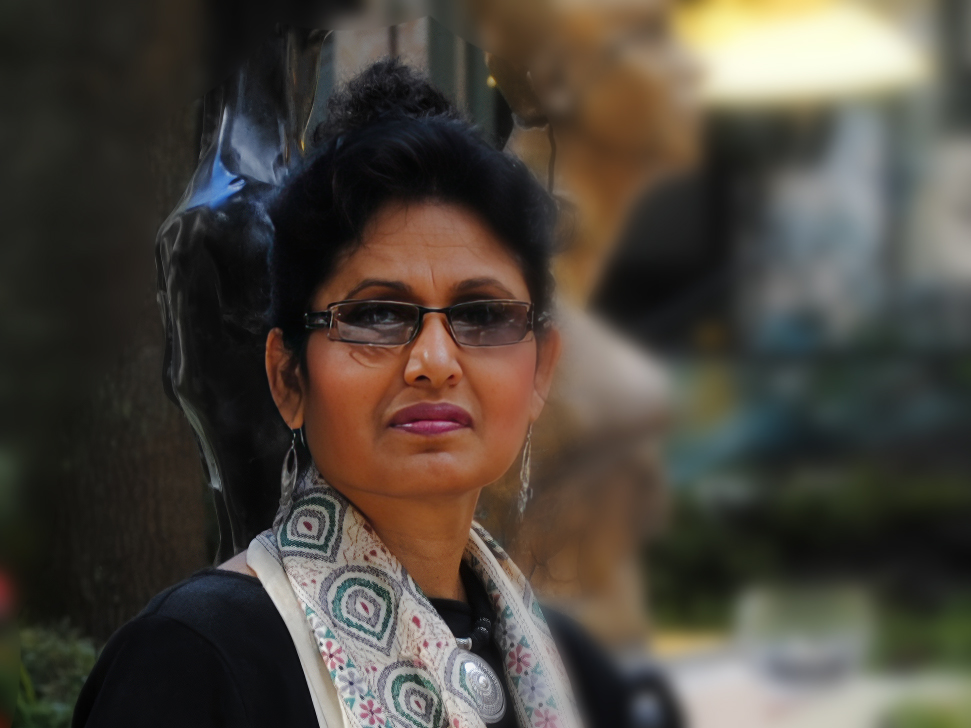When Minakshi De was born in 1958, the area where her Hindu family lived was called East Pakistan. Then came the bloody Bangladesh Liberation War of 1971. Estimates of fatalities during the nine-month conflict that resulted in Bangladeshi independence range from 500,000 to 3 million. Most, like De’s own family, were Bengali Hindus.
“A lot of people didn’t consider what was happening in Bangladesh as a genocide,” De says. “But I lived it.”
Indeed, even the United Nations has never applied the term “genocide” to the mass killings of Bangladeshi intellectuals–doctors, professors, writers and engineers–and others. Many of those murdered were left in large, common graves. But as early as March, 1971–soon after the war began–then-Prime Minister Indira Ghandi of India did describe the killings, sexual violence and ethnic cleansing in the region that went on to become Bangladesh as “genocide.”
Minakshi De’s grandfather was a zamindar in Chittagong, East Pakistan, later part of Bangladesh. This meant her grandfather–a large landowner–would take care of the impoverished people living on his land. His generosity was ecumenical, ignoring conventional divisions between Hindus and Muslims.
“Everyone would come to my grandfather for help,” De explains. “He would invite the whole village to come to the house for all kinds of festivals, whether they were Hindu or Muslim. We would celebrate both Hindu and Muslim festivals, despite our being Hindu.”
The official Partition occurred in 1947, dividing British India into the three separate nations of India, Pakistan, and East Pakistan. De’s grandfather owned property in both Calcutta, India, and Chittigong, East Pakistan; four of his sons, De’s uncles, stayed in Calcutta, while her father and her other uncles remained in East Pakistan.
De recalls few challenges as a Hindu in the years before Liberation.
“Honestly, during that time in East Pakistan, Hindus, Muslims, Buddhists, and all other religions would all enjoy festivals together and celebrate at each other’s houses,” she says.
De was 13 when Sheikh Mujibar Rahman, the first president of Bangladesh, declared the Liberation Movement on March 15, 1971. As the violence towards Hindus escalated, De and her family knew they had to leave the country.
The shortest way to get to India was through Agartala, a city near the border of East Pakistan and India. However, a criminal group supporting the mass killing of Hindu’s named the Razakar Bahini thwarted her family from taking this route.
“They showed the military our house, saying ‘this is a Hindu house,’ and they started shelling our building,” De says. “When that started, we ran in the other direction from Agartala, running from village to village, looking for other ways to get to India. After we left, all the village people whom my grandfather took care of looted everything from our house,” she remembers.
With 15 other members of her family, including six other girls ranging in age from six to twenty, De packed into a van to make the journey. This group included her father, a physician, and her four siblings.
Eventually the family reached a mountainous area of Bandarban, East Pakistan, remaining in the village of Ruma Bazar.
“When we got there, my father talked to the local Chakma tribal people, asking them how to get to India,” De recalls. “They told us we had to walk for three days to get there. My father was very afraid of the news coming from the city. We heard a lot of stories about the genocide, people facing rape, and so many other things. So my father was very scared about what would happen to us. This was his only goal, to get us to safety.”
Two soldiers joined her family on their walk to India’s border. “One was Hindu, one was Muslim,” she says. “We were the first batch of people to travel this road.”
After three days, De and her family arrived in Parba Camp, a Hindu camp in the Mussoorie District of Northern India. De and her family had to take a circuitous route, traveling around the border of East Pakistan and India—nearly 2500 miles to reach the most northern part of India. Yet, their journey wasn’t done.
“It took us two months and two days to arrive in Calcutta,” she says. “We walked from one camp to another, until a truck drove us to Meghalaya, a state in North India. Finally, we had some sort of shelter, and could take the train to Calcutta.”
Once they arrived at Calcutta train station, De and her family had to stay in the station until morning to avoid getting attacked by Indian nationalists who didn’t want people from Bangladesh, or “Bangladeshis,” coming into the country. After a long night of waiting anxiously, De and her family took a taxi to her uncle’s house, where they were welcomed by a large meal, new shoes, and new clothing.
On December 16, 1971, Bangladesh declared independence, and the Liberation War was over. At last, De and her family returned to Bangladesh to rebuild their house, and their life.
Bangladesh was created as a secular state, as neither Muslim or Hindu, and, for its first five years, that policy continued. Today Bangladesh is the world’s seventh most populous country, yet is no longer secular.
Back in Bangladesh, De studied the fine arts at the University of Chittagong, eventually meeting her husband Niladri De, who came to the United States in 1980 to receive a master’s degree in Business Administration. De followed him after she finished her own college degree in 1981. Three years later, her son, Kingshook De, was born in Dallas, Texas. After six years, they returned to India to stay with her in-laws, remaining in Calcutta for 24 years, where her daughter, Rishika De, was born.
De describes this period of her life in Calcutta as a “golden era” for her. She was deeply involved in her artwork and gallery, specializing in acrylic paintings of natural landscapes with many focused on the theme of nostalgia from her childhood in what was then East Pakistan.
In 2006, De’s children came back to the United States for higher education, settling in Florida, where she soon followed after. Today, De lives in Vero Beach, Florida, with her husband, who runs a gas station. She continues to create art, exhibiting locally and specializing in more symbolic and surrealist work following the themes of migration, displacement, and the unacknowledged genocide of Hindus in what was then East Pakistan.
When De reflects on the war, she recalls,“So many Hindu girls were raped and forcefully converted. Our parents told us to learn some quotes from the Quran to save our lives, just to show the Razakar Bahini we were ‘Muslim’ girls. They tried to confirm whether a person was Hindu or Muslim by forcing them to take off their pants or lungi’s [types of dresses] to check if they were circumcised or not.
“After the war, it was a terrible feeling when we saw all the Hindu houses burned or looted,” De continues. “I don’t know why this genocide does not get more attention than others.”
Today, she says, “My life is like a river, appearing smooth from above but with many violent currents beneath the surface. I’ve faced so many struggles in my life, and moved from country to country, but nothing has stopped my painting, my creativity. This is my blessing from God.”

